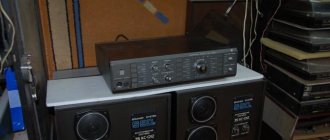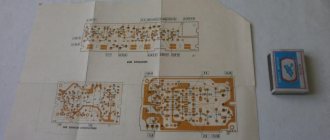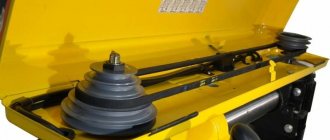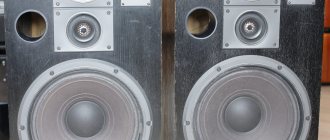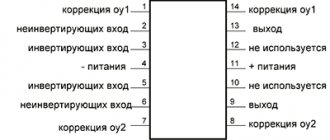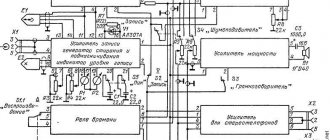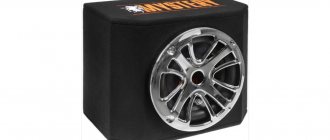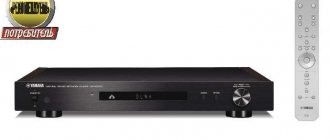Soviet HI-FI and its creators: “Corvette” goes to heaven or the last triumph of VNIIRPA named after. Popova
We will talk about one of the latest impressive developments of domestic column manufacturers, which, due to the change of GOST standards and different industries, received many names. This speaker system is best known as “Corvette” 75AC-001, also called “Cleaver” 75AC-001”, “Corvette” 150AC-001”, “Cleaver” 150AC-001”, “Korvet 300”. But we’ll deal with the names a little later.
To begin with, I would like to note that, according to the majority of contemporaries of these speakers with whom I had the opportunity to communicate, and simply people who are well versed in acoustic systems, this development is VNIIRPA named after. Popova became the best speaker in the USSR. So, below the cut are descriptions of the capabilities of Soviet engineers and the conditions in which they worked, traditional for this series, as well as a brief overview of what they managed to create, i.e. “Corvette” 75 AS-001.
Development under conditions of perestroika, glasnost and pluralism
We can say that the ever-memorable “perestroika”, “glasnost” and everything that came with them after 1985 had a positive effect on the development of Soviet audio equipment for some time.
Thus, more Western equipment appeared in the Union, more literature from the decaying West, and the opinions of class-alien engineers began to be listened to more often. The fruits of liberalization were not long in coming. At the end of 1986, a group of engineers from VNIIRPA named after. Popov began the development of an acoustic system with characteristics unprecedented for that time.
According to the approved technical specifications, it had to be a speaker with a high level of sensitivity, the ability to withstand short-term power values of more than 250 W, and have effective overload protection.
In addition, from above, having learned about such a promising and ambitious development, they lowered the task of preparing the speakers for the assault on foreign shelves. For after the “Brig” amplifier and the “Corvette” electrophone (to which Likhnitsky also had a hand), the Soviet high-fi had no significant victories behind the rusting iron curtain.
To implement such an ambitious task, the best specialists from VNIIRPA named after. Popova. Modeling and determination of the optimal parameters of loudspeakers and crossover filters were carried out on computers for the first time.
Considering the need for an export version, all possible resources were used, all mechanisms were turned on, thanks to which samples of the new speaker were ready for testing in less than 2 years, which can be considered a Stakhanov result for Soviet column construction.
The first damn thing is lumpy
Despite the green light, the first prototype, which was almost launched into large production, failed the final tests.
Not many people know that the first version of the speaker was planned to have 2 bass reflexes. Incorrect acoustic design of these bass reflexes led to the appearance of pronounced and extremely undesirable resonant modes, which did not behave well with a complex musical signal.
This drawback became critical in order to prevent the speakers from being put into mass production. Interestingly, passports for new products have already been printed. The picture, kindly published by ldsound.ru, indicates that an early version of the documentation included an image of speakers with two bass reflexes.
The deficiencies in the bass reflex design were quickly eliminated and in the same year a prototype was presented for testing, which later became a production model. The “canonical” bass reflex of this acoustics was designed with a pipe diameter of 75 mm and a length of 91 mm, which provided tuning at 36 Hz.
Design, features and technical specifications
The plan to create Soviet acoustics competitive in the Western market was not only carried out; in the realities of the perestroika “scoop”, the appearance of such speakers seemed impossible.
At that time, the technical solutions used in the 75AC-001 were used primarily in the high-end segment. The acoustics received the best bass speakers produced at that time in the Union - 100GDN-3, mid-frequency - 30GDS-1 and dome tweeters - 10GDV-4. For 1988, this was a new generation of loudspeakers that were able to provide a sensitivity of 91 dB(W/m), comparable to the best examples of Japanese and European acoustics of that time.
The frequency range was significantly increased, the resin speakers could reproduce the low-frequency spectrum starting from 25 Hz, and the tweeters generally went beyond the limits of frequency perception and could emit ultrasound at a frequency of 25,000 Hz.
The unevenness of the frequency response did not exceed -3 dB, distortions in the entire frequency spectrum and in the entire range of operating long-term power were within 1% (probably they were less, but the measurement accuracy did not allow this to be determined). Surprising for Soviet acoustics was the high uniformity of the phase response, achieved thanks to the successful design of the filters.
To get a complete picture of the device, I suggest you evaluate the technical characteristics:
- Reproducible frequency range: 25 (-19 dB) – 25000 Hz;
- Frequency response unevenness in the range 100 – 8000 Hz: ±3 dB;
- Sensitivity: 91 dB;
- Characteristic sensitivity: 0.73 Pa√W;
- Nominal electrical resistance: 8 ohms;
- Minimum value of total electrical resistance: 6.4 Ohm;
- Noise power limit: 100 W;
- Limit long-term power: 150 W;
- Maximum short-term power: 300 W;
- Weight: 30 kg;
- Dimensions (WxHxD): 38.6x71x34 cm.
Another characteristic feature was the optimal volume of the housing, sufficient for the speakers, and the use of effective damping material ATM-1 made of staple super-thin glass fibers. This made it possible, with optimal damping, to provide expressive, “deep” reproduction of low frequencies.
For the first time in the Soviet system, wall-mounted installation on a cardboard base was used. The filter design used air-core coils with wire of sufficient cross-section. Metal-paper capacitors MBGO of optimal capacity were also used, which were characterized by small losses and minor distortions.
From the point of view of sound, according to one of the authoritative authors of the portal “there are no schemes”, the most harmful thing was the protection system. Considering the purpose of the device, the features of its application and its impressive power, its anti-overload limiters turned out to be superfluous.
And how harmful they are to sound, people who understand circuitry and electroacoustics can draw a conclusion from the diagram below.
Also, many argue that significant harm to the sound is caused by cables of disproportionate length, which were used to use acoustics not in household, but in the so-called. semi-professional conditions (corporate gatherings, school discos, etc.).
Mass production
It is difficult to escape from the system, especially from the Soviet one.
You can find talented engineers, purchase samples of foreign technology for study, provide developers with a “green light” to obtain scarce instruments and materials in the quiet whirlpool of a planned economy, open all the bureaucratic “locks” with a “crowbar” of administrative resources,” but somewhere there is a strong regressive system will still put the pig down. In this case, mass production became such a pig. Where the merciless Soviet rationalizer could not save, where the Soviet engineer did not hack, where the Soviet leader did not stick his omnipresent nose, and the Komsomol organizer did not drag in the ideology, the sinewy hand of the proletarian “saved.”
The new acoustics went into series with the names “Corvette” and “Cleaver”. Its serial production was puzzled by the flagship of the production of the Soviet hi-fi "Okeanpribor" (in St. Petersburg) - "Corvette" and the plant "Krasny Luch" (in the city of Krasny Luch) - "Cleaver", which also produced speakers for this acoustics.
The first problem of the series was the immediate replacement of high-quality damping ATM-1 (for some reason, very necessary for the workers of this enterprise) with banal cotton wool. Moreover, it is good if an adequate amount of cotton wool was used.
The second problem was the production “ratsu” of the early 90s, which mainly concerned “Okeanpribor” (Likhnitsky also complained about this in his memoirs). First, we simplified the recipe of the multicomponent compound with which the diffusers of the 30GDS-1 midrange drivers were impregnated. Then they excluded “as unnecessary” the internal vibration insulation of the speaker housing.
The situation was somewhat different with the export version of the acoustics, which was structurally no different from its counterpart for the domestic market. At the same time, judging by the surviving copies, theft was probably less. Its design and features can be judged from the photos published by the already mentioned ldsound.ru
Epilogue
Mass serial production of the last impressive achievement in Soviet HI-FI continued until 1992, after which production volumes fell sharply and then stopped altogether. In my opinion, the history of this speaker, like other serious developments in the field of high-fidelity equipment, demonstrates the abilities of Soviet engineers, the quality of their education and qualifications. In addition, it makes it possible to assess the complete unviability of the Soviet system of remuneration for labor, management of the production of household equipment and a planned economy.
Jeans
Our catalog contains many high-fidelity acoustic systems.
Photo content used from ldsound.ru
The material also uses photos of the reconstructed and modified version of the “Corvette” 150AC-001” (black body), provided by Blackmore1962, Smela, Cherkasy region, Ukraine.
